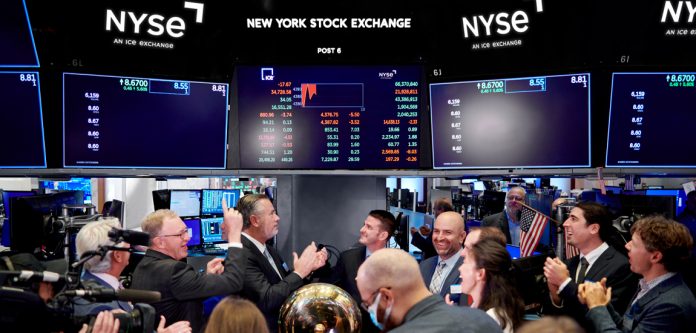US Stock markets in the United States recorded gains on Monday following the White House’s announcement that tariffs would not be imposed on certain Chinese-made electronics, including smartphones.
The development, announced early Saturday, offered temporary relief to investors, although President Donald Trump later clarified that these products were merely being reassigned to a different tariff category or “bucket,” suggesting the rollback may be short-lived.
Across the Atlantic, European markets mirrored the positive sentiment. The UK’s FTSE 100 closed with a 2.1% increase, while major indices in France and Germany also saw notable upward movement.
Despite Monday’s rebound, global equities remain lower than levels seen prior to Trump’s controversial “Liberation Day” tariff declaration on April 2.
The global financial markets had experienced unprecedented declines followed by sharp recoveries after Trump’s decision to suspend numerous tariffs for a 90-day period. Under the new tariff framework introduced by the Trump administration, most Chinese imports into the US were hit with a 145% levy, prompting a retaliatory response from Beijing, which imposed a 125% duty on American goods entering China.
The White House is expected to unveil new tariffs on semiconductors later on Monday. Electronic items like smartphones and computers, currently exempt, are anticipated to be included in this next tariff round.
Wall Street reflected investor optimism during Monday’s session. The Nasdaq, dominated by technology stocks, closed 0.78% higher. The S&P 500 gained 0.79%, and the Dow Jones Industrial Average added 0.64%.
Tech giant Apple, which relies heavily on Chinese manufacturing for its iPhones destined for the US market, experienced a 5% surge in early trading before ending the day up by 2.2%. Other technology firms such as ASML and Dell Technologies also posted gains.
“Investors were so eager for some positive tariff developments that they largely overlooked the potential complications that may still be on the horizon,” remarked Danni Hewson, head of financial analysis at AJ Bell.
Nevertheless, Monday’s uptick has not fully recouped the market losses incurred since the initial tariff measures were announced. Over the past month, the S&P 500 has dropped by 4.3%, the FTSE 100 by 5.8%, Germany’s DAX by 8.8%, and France’s CAC 40 by 9.4%.
In currency markets, the US dollar continued to weaken on Monday, declining 0.8% against the British pound. Since Thursday, the greenback has lost 2.8% of its value against sterling.
Susannah Streeter, head of money and markets at Hargreaves Lansdown, attributed the dollar’s weakness to anticipated economic damage in the US. “Although the dollar is traditionally seen as a safe haven for investors, Trump’s approach has undermined confidence in the US on the global stage,” she said.
Bond markets remained steady at the start of the week. A key yield on US government debt dropped to 4.4%, still elevated compared to pre-April 2 levels. The same rate had spiked last Wednesday, as investor fears of a potential recession triggered a selloff in US Treasury bonds, typically viewed as secure investments.
President Trump and his allies continue to defend the current market volatility as part of a broader “transition” toward encouraging domestic production and boosting employment within the US.
However, numerous economists and industry leaders argue that reshoring manufacturing operations could take years and that ongoing tariff uncertainty could inflict lasting harm on the American economy.













